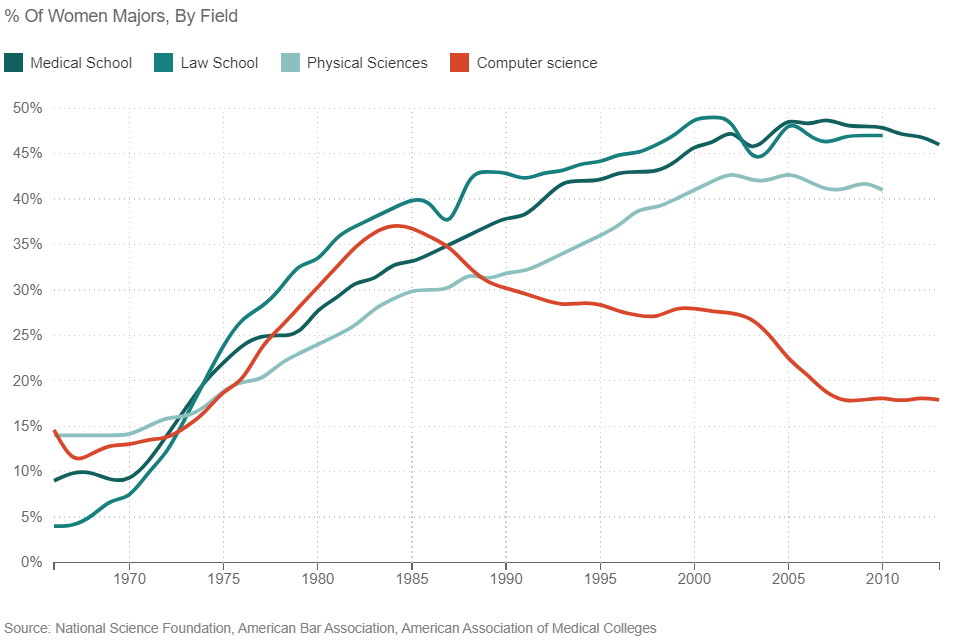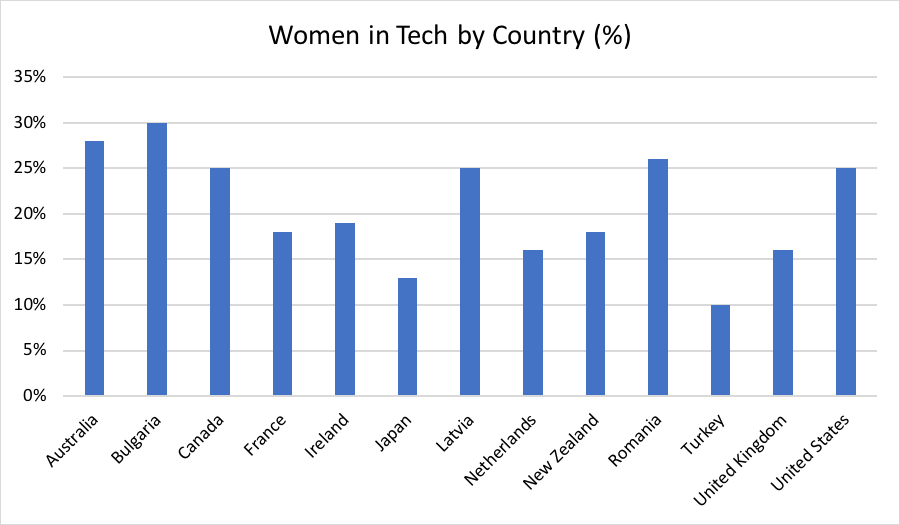A Brief History Lesson
There is currently a large disparity in the percentage of female vs male Software Engineers. According to Wise women make up just 16.4% of the IT Engineering workforce. In education another study shows that Computing has one of the lowest take-ups by women across all Engineering categories, with just 16% of degree candidates being female.
But it wasn’t always this way. There have been plenty of female role models within software engineering in the past, in fact computers wouldn’t be what they are today without these pioneering women:
- Ada Lovelace (1815 – 1852) - regarded as the first computer programmer
- Grace Hopper (1906 - 1992) - a computer programming pioneer who invented the compiler and theory behind high-level programming languages
- Dorothy Vaughan (1910 - 2008) - NASA’s first African-American manager, taught herself and her staff Fortran
- Mary Kenneth Keller (1913 - 1985) - first woman to earn a doctorate in computing in the US, part of the team who created BASIC
- The ENIAC Programmers (1945) - 6 women who were the first programmers of the first digital computer
- Carol Shaw (1955 - ) - one of the first female game designers
- Radia Perlman (1958 - ) - invented the spanning-tree protocol, and contributed to many areas of network design and internet routing
Computer technology really emerged during World War II, at this time women made up the majority of the engineering workforce. By the 1960s men made up a large majority of all workers. But in software more than one in four programmers were still women. Computing was largely seen as a woman’s job, and women benefitted from a positive stereotype at this time. However there was a large pay gap between women and their male counterparts, according to the book Recoding Gender: Women’s Changing Participation in Computing, in 1969 the median salary for female computer specialists was $7,763, where men earned a median of $11,193 doing the same job! In spite of this, until 1984 the uptake of women in software engineering was increasing. According to the below graph (admittedly from an American source) the percentage of women studying software engineering degrees topped out at 37%, and has been declining ever since.

There are many theories for the growing gender disparity. One possible reason is the 1970s recession meant programmers weren’t in demand at this time which could have led to a drop off in female uptake in the field. Another potential reason is the production of personal computers increased the male uptake in software engineering. A 1985 Apple advert showed how much a computer could help boys, and showed a boy teasing a girl who was trying to use a computer. Advertising like this caused stereotypes to shift and computers became perceived as a thing for boys.
How the UK Compares
As previously stated, women make up just 16.4% of the IT workforce in the UK. But other countries have a much higher percentage of women in this area. The graph below shows several countries where women make up 25% more of employees in their tech industry:
 Image from: European Women In Tech
Image from: European Women In Tech
According to Unesco, 50% of Malaysia’s engineers are women, and for Oman the figure is 53%. These figures highlight that the UK doesn’t do well when it comes to gender diversity in the workplace, and that there is lots of potential for improvement in this area.
At the time of writing, within Capgemini women make up just over 30% of our junior grades but this decreases to less than 20% of our senior grades and roles. At Capgemini in India, women employees constitute over 35% percent of our workforce. Within our Open Source Cloud Engineering team women make up just 15.4%.
Women in software today
There is lots of work going on to improve gender diversity in the workplace. For 5 years in a row Capgemini has been included in the Times Top 50 Employers for women list. There are also lots of female role models around today, such as:
- Parisa Tabriz - A Director of Engineering at Google
- Juliana Rotich - A tech entrepreneur and strategic advisor
- Shafi Goldwasser - A pioneer in cryptography, won the Turing Award in 2012
- Jade Raymond - A video game developer, led the creation of Assassins Creed, founded Ubisoft’s Toronto subsidiary
- Sara Haider - Engineer for Android apps at Twitter, she was the leader of development for Vine that had 200 million users at its peak
- Amanda Wixted - An iOS app developer, led development of FarmVille, founder of Meteor Grove Software
- Women at Capgemini - Capgemini have many great female engineers
There are a lot of stereotypes that are still being applied to women in software engineering, but this is no longer tolerated within mainstream companies. In 2017, a Google employee named James Damore wrote in an internal email about qualities he thought were more commonly found in women. This included higher rates of anxiety, and he assumed this explained why they weren’t thriving in a competitive world of coding. Google fired Damore, however his opinion does reflect what some people within the software industry think, and highlights the stereotypes that are often applied. Most companies though do not allow this kind of behaviour, and the Capgemini software engineering team responded to Damore’s comments with this blog post.
Another issue that is still prevalent is the pay disparity between genders. This is often caused by men holding more senior positions within a company compared to women. The gender pay gap for the UK was 15.5% in 2020 according to Statista, this gap has been narrowing in recent years and is down from 27.5% in 1997.
What can be done
Having researched the statistics of various countries, and worked with many women, I can safely say they are just as capable as men at software engineering. In fact gender diversity benefits businesses in the same way that any diversity does, more ideas and increased flexibility leads to better products! There are many stats that show having a better gender balance increases the profitability of a company, for example Forbes and Gallup. Being more gender diverse leads to a more innovative business, as diverse employees come with different experiences and viewpoints. This increases a businesses ability to solve problems which is key in the software engineering game. According to the 2011 census women make up 51% of the population in England and Wales, that is a lot of potential talent that software companies could be tapping into. At the moment with a male dominated workforce we are only utilising 49% of the talent available. Imagine what could be achieved with 100% of that talent! I personally quite fancy a smartphone that is also a robot, I think this one is in need of some gender diverse talent!
We have a role as engineers to ensure the workplace is a fully inclusive space. There are many stereotypes and unconscious biases around female software engineers that aren’t true and aren’t acceptable within todays society. Everyone has a responsibility to stop any prejudice they encounter. Capgemini does a lots of work in this specific area, and has published an Active Inclusion Strategy which specifically highlights unconscious bias, and includes a range of materials and information to try an combat any unconscious bias coming from a lack of awareness/information.
The gender diversity gap in software engineering isn’t something that can be solved overnight, but we can all play our part in helping to encourage more women into software engineering careers.